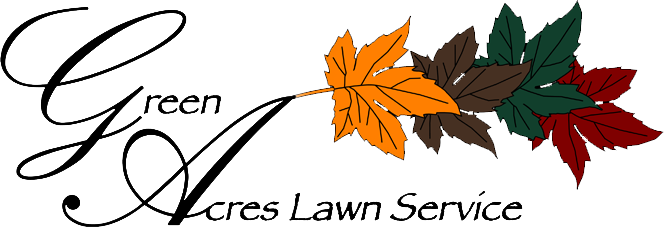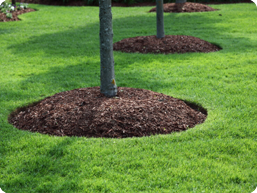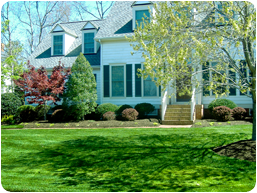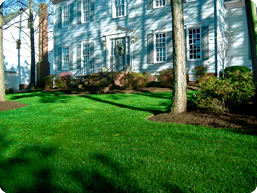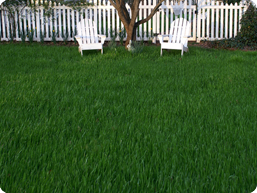Below are 4 categories of tips for maintaining your lawn and landscape. We encourage you to review our recommendations of caring for and improving your lawn. If you have a specific question please feel free to contact us and we will be more than happy to provide advice or if you would prefer we will provide you with a fair price to handle the issue.
Mowing
These tips are designed to help you get the best results from for your lawn with your mowing practices. While this is general advise, please keep in mind that every property is different and circumstances may require altering from this advise.
Mow as high as possible (4 - 5 inches for tall fescue)
Helps shape out weeds
Keeps lawn cooler to reduce "burn up" in summer
The height of the grass is equal to the length of the roots
Try not to mow more than 1/3 of the height of the grass with each mowing
This is very stressful to the plant and seriously risks burning the turf
Adds too much thatch to the lawn
Keep your blades sharp
Sharp blades cut grass instead of tear grass
Torn grass looks ragged and leaves white tips when finished mowing
Clean cut grass heals faster which greatly reduces risk of turf disease
Always disconnect spark plug before removing blade
Return grass clippings to lawn
Adds nitrogen back to the lawn naturally
Adds organic material back to lawn
Reduces environmental impact keeping clippings out of landfills
Less work for you not having to stop and dump bags
Keep underneath mower deck clean
Grass and dirt will build up underneath mower decks
Build up reduces the vacuum effect of mower and will leave more uncut grass
Try to mow grass when dry
Just does a better job cutting and is easier on operator
If grass does need to be mowed when wet, be sure to pick up or scatter any clumps left on the lawn. These clumps will block light and leave yellow spots
Always weed eat and edge
This gives your lawn that finishing touch that makes it look well manicured
Keep your mowing equipment regularly maintained
Mower maintenance is pretty easy and will greatly increase the life of your equipment
Change oil, air filter, and spark plug once per season
We recommend using a product like Startron® during the last mowing to reduce the harmful effects of ethanol
Watering
These tips are to serve as a watering guideline only. While this is general advise, please keep in mind that every property is different and circumstances may require altering from this advise. If we get rain, then the following times should be altered to only provide supplemental amounts of water until your plantʼs requirements are met.
Lawn
Your lawn requires about 1 1/2 inches of water per week
Drought stressed turf will begin to look grayish and leave footprints when walked across
Start off in the fall by giving your lawn as little irrigation as possible to encourage deeper root systems
Continue supplemental watering as little as possible throughout the spring
Remember that watering less and mowing high results in the turf having deeper roots which will make the grass much more drought resistant for the hot summer months
In the summer, water more frequently but still give the lawn a good deep soak rather than more frequent short watering
General guidelines for irrigation systems (Note that these guidelines are based on rotary style sprinkler heads. Mist head sprinkler heads apply about 3 times as much water, so times should be reduced by 1/3 of the time) :
all (established lawn) - 45 min. to 1 hour per zone once per week
Spring - 45 min. to 1 hour per zone once per week
Summer - 30 min. per zone 3 times per week
Try to avoid watering the day before and day of mowing
During late spring and summer, water in the morning which will greatly reduce the chance for developing turf disease
Newly seeded turf
Water 2 or 3 times per day (depending how hot it is) immediately after seeding for short intervals (5 - 10 min. per zone for rotary heads and 4 - 7 min. per zone for mist heads) for 1 1/2 to 2 weeks until seed germinates
You want to keep seed moist but do not want water to pool up or ground be remain muddy
If you’ve over seeded and pre existing turf needs to be cut, cut off water long enough for grass to dry out and be mowed before resuming watering
Begin watering less frequently but increasing the time gradually until you are watering at the normal fall guidelines of 45 min. to 1 hour at once per week
Ornamental Plants
Most plants require less water than your turf
Don’t just let the sprinkler heads for the lawn water your landscape plants. You should either have separate zones for your landscape or water by hand
Newly planted material will require more frequent watering than that of established plants
Newly installed sod
New sod should be water 1/2 inch with each watering
Water all new sod immediately after installation or every 30 minutes during installation if above 85°
Watering frequency guidelines are as follows:
Temps. 32°-60° Every other day for 2 weeks
Temps. 60°-85° Once every day for 2 weeks
Temps. 85°and above Twice every day for 2 weeks
Afterwards, follow the guidelines for established turf listed above
Landscaping
These tips are designed to help you with your landscape choices and maintaining your existing landscape. While this is general advise, please keep in mind that every property is different and circumstances may require altering from this advise.
When making a plan for landscaping, look at how you can make the most use of your space where it will accommodate your lifestyle, not just beautify your home
What are the times of year you are more likely to be outside or entertaining guests outside?
What do you and your family enjoy doing in the outdoor spaces around your home?
Do you have pets and what habits do they have that need to be considered?
Right plant for the right place
This is the most important thing to keep in mind when choosing plant material
Be sure that soil type, amount of sunlight, and drainage are right for the plant thatʼs chosen
Be sure to chose a plant based on itʼs ultimate height and width that will work in your location. Too often we see plants that are too large for where they are in the landscape which results in a maintenance nightmare or having to remove the plant altogether
How much water will they need relative to how much you can provide
Planting guidelines
Dig your holes twice the width and 1 1/2 times the depth of the root ball
Be sure the soil you return to the hole is broken up well to allow roots to easily move into the new soil
Rough up the root ball to prevent the roots from “girdling” the trunk
If dealing with heavy clay or sandy soils, you may want to amend the planting soil with compost or a topsoil / compost blend
If plant material requires good drainage, you can always build a raised bed for planting
Be sure to firm up soil (not compact it) around root ball to keep your plant from shifting when soil settles
In heavy clay soils, we recommend planting so that the top of the root ball sets from 2 to 4 inches above ground level and then mulching around it
Do not stake trees unless they start to lean after planting. They will grow stronger if left without assistance
Miscellaneous
Use annuals and perennials in your landscape as an inexpensive way to give it a splash of color or some more unusual texture
Consider what you may already have an dhow it could be used before purchasing new plan material
Be sure to look at insect and disease pests relative to your plan to
Problem Solving
These tips are designed to help solve some common lawn and landscape problems. If these donʼt help, feel free to contact us to come to your place and evaluate the problem for you, free of charge.
Lawn weeds?
If they are grassy weeds, did you use a pre-emergent and was it applied early enough? There are post emergent herbicides for crabgrass and other grassy weeds that can be used in your lawn. Be sure you are correctly identifying the weeds before attempting treatment
If you are dealing with broadleaf weeds, there are several treatments available which will treat an array of different weed species. Once again, proper identification will save you time and money
Mowing your lawn high will help to shade out weeds
My lawn has brown spots!
If itʼs hot and humid outside and your lawn is getting enough water, you may have a disease which will need to be treated with a fungicide
If itʼs hot and we are not having much rain, you are probably dealing with drought stress. Fescue naturally will go dormant during hot weather and come back to “life” once the temperature gets cooler and we start getting more rain. You still want to provide 1 1/2 inches per week, even if the grass doesnʼt get green. This will keep it living.
Chemical spills or pet urine can cause brown spots in the lawn. You may contact us for help on correcting these problems
Every year I reseed and the grass comes up beautifully, but then, in certain places, it dies out in the summer
Power seeding can be very effective for these spots
You may have localized dry spots that donʼt retain moisture where adding an amendment to the soil there before seeding could help
Your irrigation may not be hitting or covering that area as well
If you have large trees nearby, they are probably competing with the grass for moisture, sunlight, and nutrients, and the trees will always win. We recommend giving up the grass in that case and creating more bed space
My lawn is so this!
Are you aerating and over seeding every year? Virginia is a tough place to grow grass. Typically, we are trying to grow tall fescue which is a cool season grass
Our summers are anything but cool and regardless of what you do, this heat will result in some turf damage that should be replenished in the fall
Are you removing leaves on a regular basis? Leaves left on the lawn can shade out the grass, especially newly seeded grass and result in thinning
Using a proper fertilization analysis for the time of year will help to keep your lawn thicker and healthier
Liming regularly keeps your ph in check to provide ideal soil conditions for your turf grasses
I have moles tunneling all through my yard. What can I do about them?
The best solution for moles are using gel baits. While some may feel that theyʼre inhumane, they are about the only thing that is effective
There are lawn sprays that will only chase them off only to return in a couple weeks and you have to repeat the process again for the same results
Grub control will protect your turf from being eaten by grubs, but does not keep moles out of your yard. Moles eat grubs, but they will also eat earthworm
There are holes in the leaves of my plants!
This could be caused by either insects or fungal disease. If you donʼt know what it is then you need to contact a professional who can help you identify exactly what pest you are dealing with
My plants keep dying when I plant them in the same area. Is something wrong in that spot?
Are you planting the right plant for that area?
You may need to get the soil tested to find out whatʼs going on
Be sure you give new plants plenty of water, especially in the summer
On the same note, be sure not to over water
